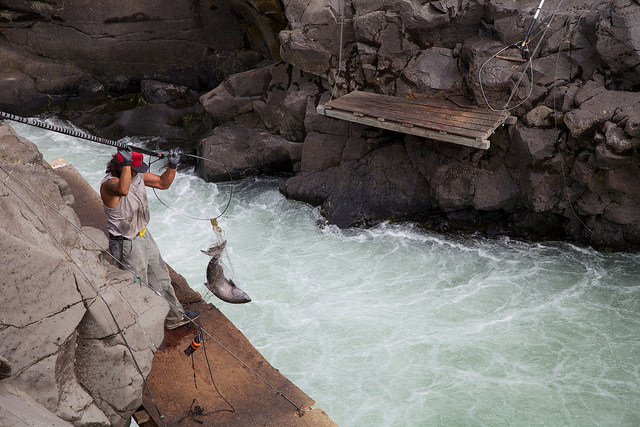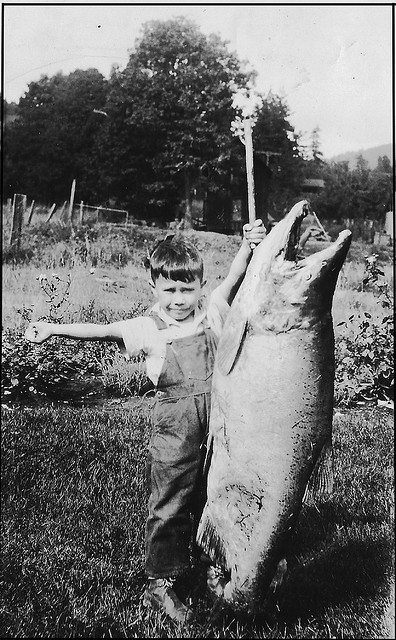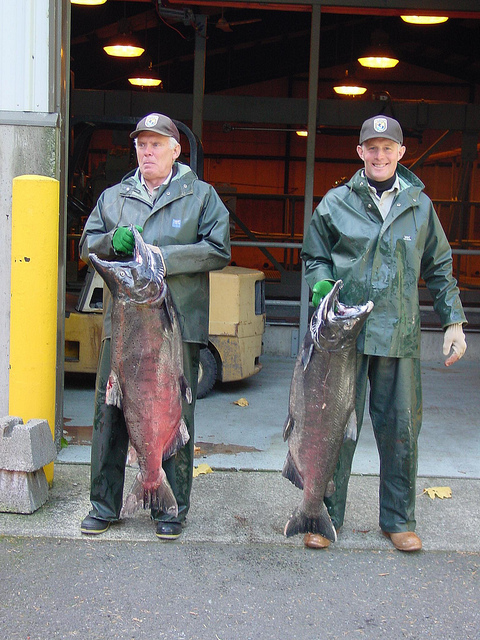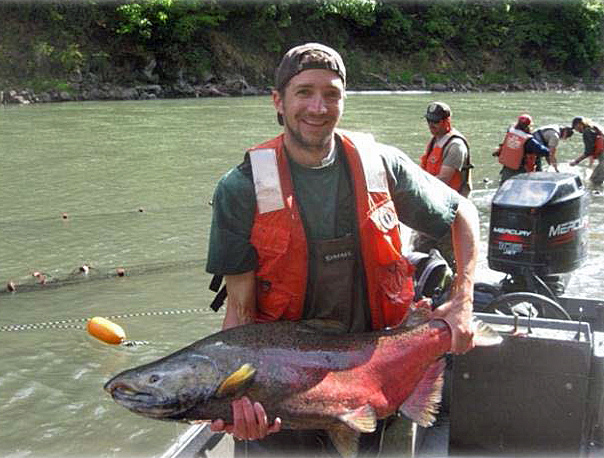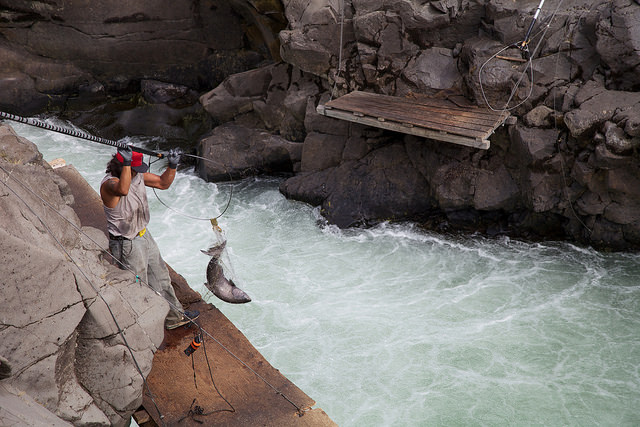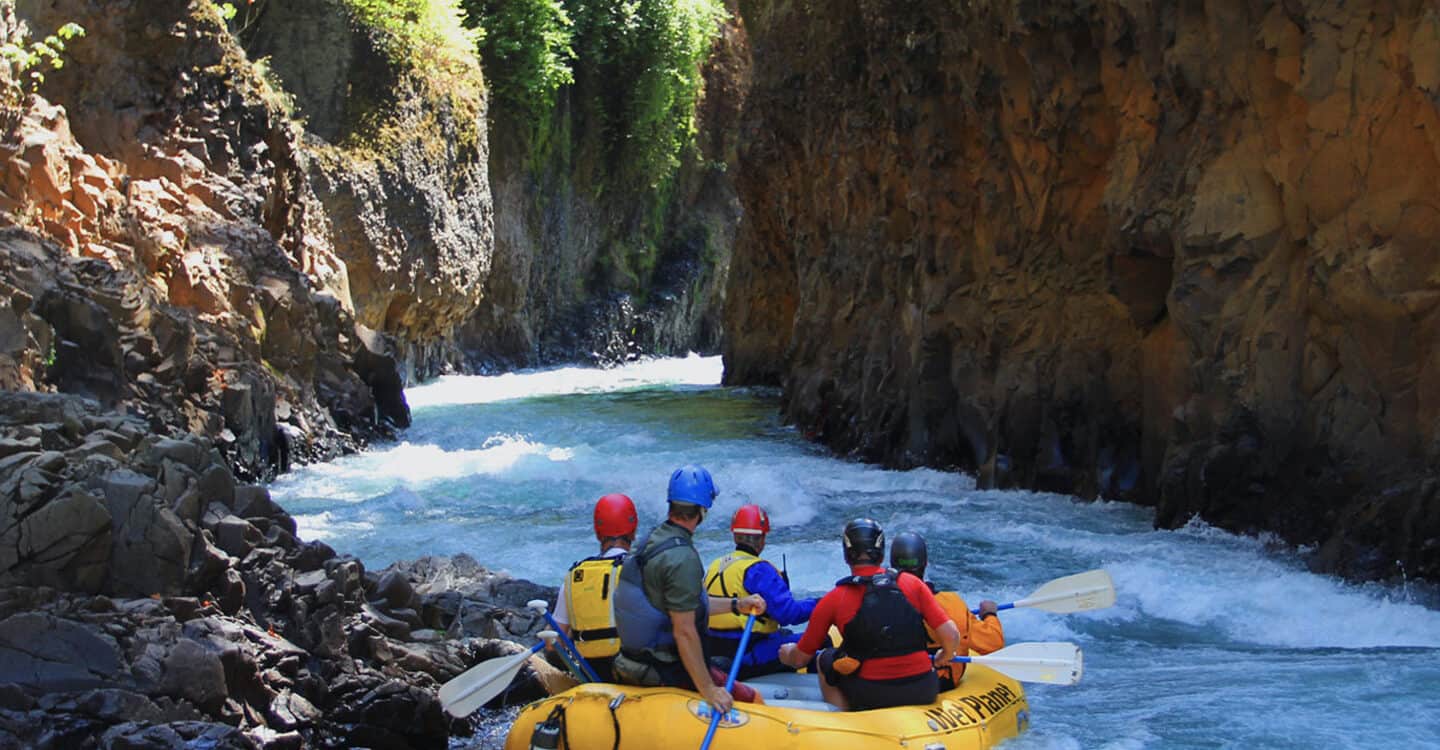The following Q&A is courtesy of Jeanette Burkhardt, watershed planner for Yakama Nation Fisheries. Wet Planet is proud to partner with Jeanette on projects like this blog series and RiverFest.
Q: Is there anything fishermen should know? Any tips for them?
Know the regulations, keep only legally harvestable fish (generally adipose-clipped hatchery salmon and steelhead), release wild fish as quickly and safely as possible, and avoid spawning salmon and steelhead.
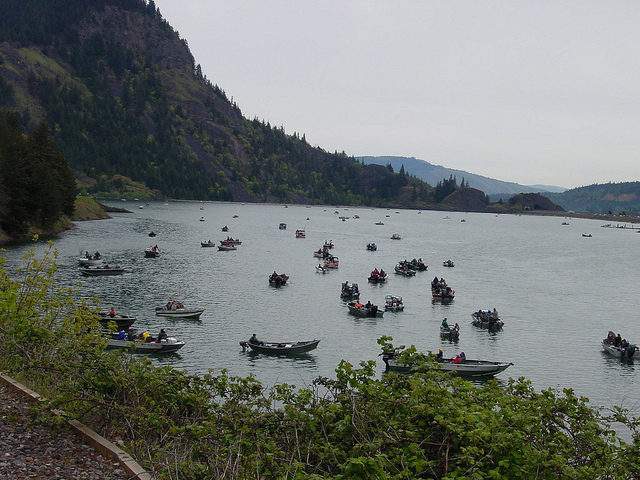
Fishermen catching salmon in the Columbia River Gorge National Scenic Area (Credit: Speros Doulos/USFWS)
Q: How much impact does fishing have on the spawning?
Since current sportfishing regulations only allow harvest of hatchery fish in the White Salmon, negative impacts to native spawning adult salmon and steelhead are probably not huge. However, this is a complex issue and would require further monitoring to answer. Excessive hooking and releasing can have an impact on the survival and spawning success of wild fish.
Q: Does the Yakama Nation have any plans for fishing the White Salmon now that fish are returning to the upper portions of the river?
Native people have fished in the White Salmon River since time immemorial, and tribal fishing is assured today by Treaty with the US government in Federal law in “usual and accustomed” places like the White Salmon River.
The fishery at Husum Falls (and others along the river and its tributaries) and the diversity of natural foods and medicines available within the watershed provided an abundance of resources within a relatively small geographic area. The tribes lived sustainably with these resources until the construction of Condit Dam in 1912-1913 destroyed the salmon runs. With the loss of salmon and increasing development of the watershed, tribal use gradually diminished over succeeding decades. The removal of Condit Dam and the recolonization of salmon in the White Salmon present tribal members with the opportunity to restore an important traditional fishery. Tribal policy directs that the salmon should be given ample time to recolonize and thrive before fisheries are permitted to harvest them.
Tribal fisheries in the White Salmon are not envisioned in the near term, but when allowed, they will be established by the Yakama Nation tribal government based on the traditions of conservation and sustainability that are inherent to tribal resource management. The fisheries will be closely monitored, as are all tribal fisheries, and managed to ensure that an appropriate number of spawners escapes to create the next generation of salmon in the White Salmon River.
Jeanette Burkhardt is a watershed planner for Yakama Nation Fisheries, a program of the Confederated Tribes and Bands of the Yakama Nation, working in the Tribe’s southern ceded lands, which includes the White Salmon River. From its inception in 1983, Yakama Nation Fisheries has employed scientific expertise in concert with traditional ecological knowledge to develop innovative projects and partnerships credited with restoring culturally important fish runs in the Columbia River. Yakama Nation Fisheries is headquartered on the Yakama Reservation, but maintains a number of field offices, and manages numerous projects across the Columbia River mainstem and sub-basins (White Salmon, Little White Salmon, Wind, Klickitat, Rock Creek, Yakima, Wenatchee, Entiat, Chelan, and Methow). Yakama Nation Fisheries focuses on culturally important fish, including: Chinook, Sockeye, steelhead, Coho, Pacific lamprey, and White Sturgeon. More information is available at: http://www.yakamafish-nsn.
Resources:
- Endangered Species Act violations: Harassing federally listed species is a federal offense. If you see someone harassing, harming or poaching listed salmon or steelhead, contact Diane Driscoll, Fisheries Biologist, Columbia Basin Branch of NOAA Fisheries at 509-962-8911 x227 OR Diane.Driscoll@noaa.gov
- Friends of the White Salmon River— Local advocates for return of anadromous fish to the White Salmon, and for protection and enhancement of the vibrant watershed that feeds it. http://friendsofthewhitesalmon.org/
- Mid-Columbia Fisheries Enhancement Group (MCFEG)— Mid-Columbia Fisheries works to restore salmon habitat in rivers and streams in Central Washington, including the White Salmon River and its tributaries. www.midcolumbiafisheries.com
- SHARE the White Salmon River is a multi-stakeholder group doing education and outreach to river users about ways to respect and protect the river (like the above bullets). Contact Jeanette @ 509-945-1617.
- Yakama Nation and MCFEG are partnering on a multi-year project restoring a ~3-acre piece of the former reservoir behind Condit Dam near the NW Park boater take-out. If you are interested in helping, we always welcome volunteers! Call Jeanette: 509-945-1617.

